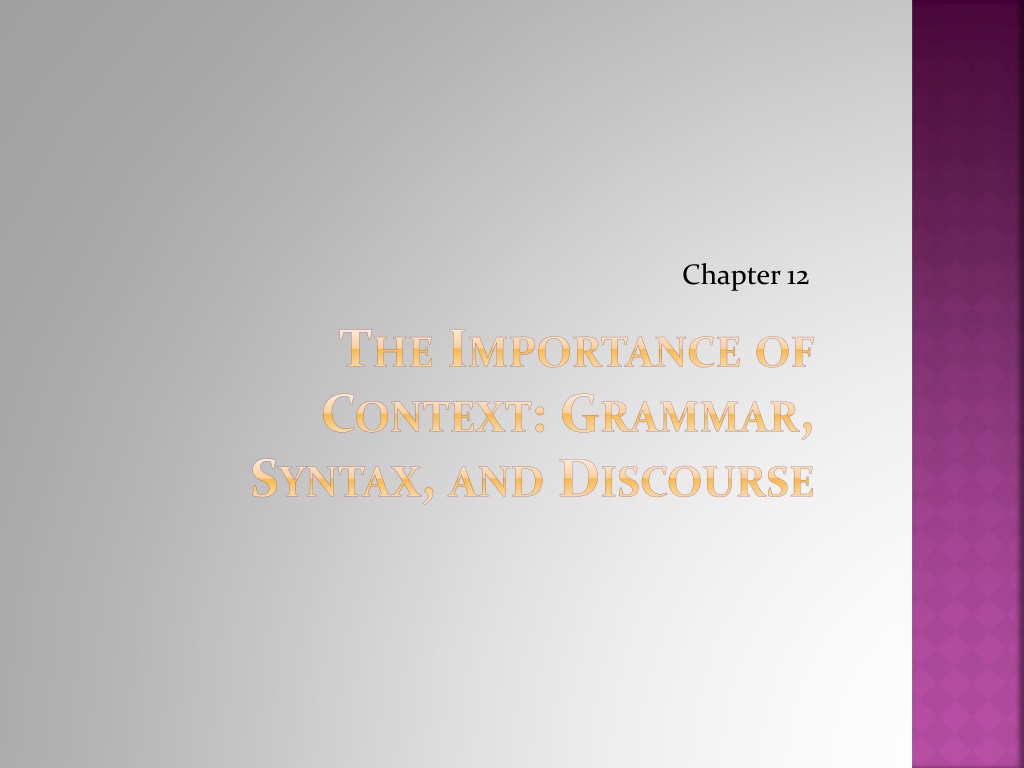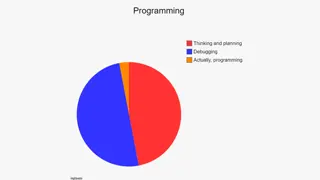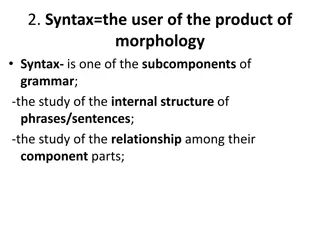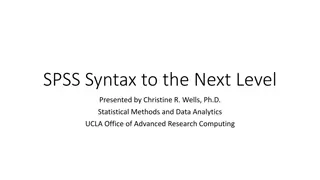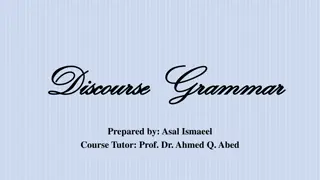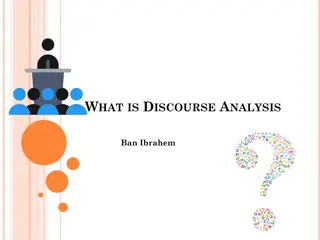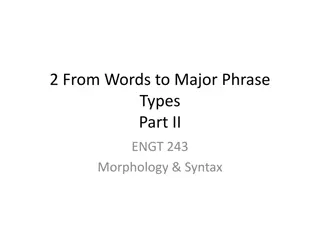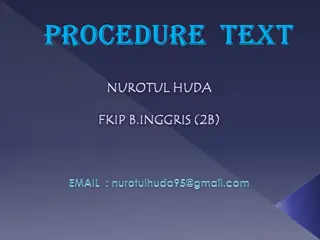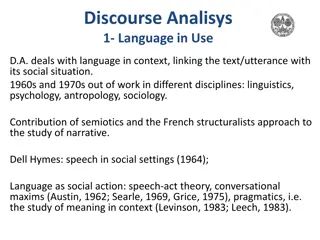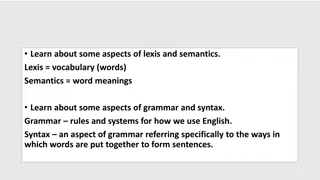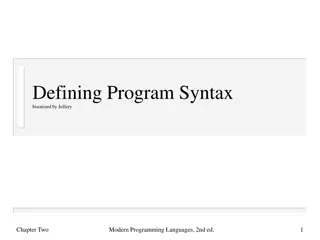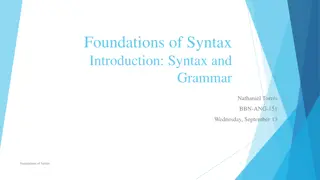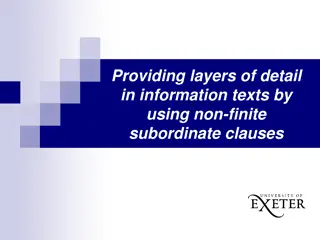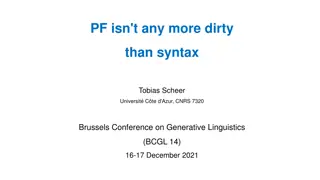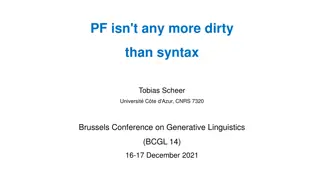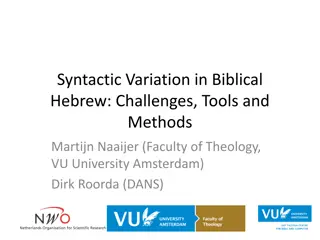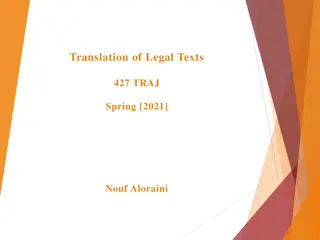Understanding Grammar, Syntax, and Discourse in Biblical Texts
Explore the significance of context in analyzing grammar, syntax, and discourse in biblical Greek and Hebrew texts. Learn about the foundational elements, word order, Greek syntax basics, and the importance of discourse analysis. Delve into the definitions of grammar, syntax, and discourse, and understand how these elements play a crucial role in interpreting biblical passages.
Download Presentation

Please find below an Image/Link to download the presentation.
The content on the website is provided AS IS for your information and personal use only. It may not be sold, licensed, or shared on other websites without obtaining consent from the author. Download presentation by click this link. If you encounter any issues during the download, it is possible that the publisher has removed the file from their server.
E N D
Presentation Transcript
Chapter 12 THE IMPORTANCE OF CONTEXT: GRAMMAR, SYNTAX, AND DISCOURSE
CHAPTER OUTLINE Defining the Terms: Grammar, Syntax, and Discourse Grammatical Foundations: Basics of Biblical Greek and Hebrew Word Order and Sentence Structure: Basics of Greek Syntax Discourse Analysis: Overview of Method Discourse Analysis: Specific Examples Discourse Analysis: Tracing the Thought Flow Guidelines for Outlining a Biblical Book or Interpretive Unit
DEFINING THE TERMS: GRAMMAR, SYNTAX, AND DISCOURSE Discourse Any coherent sequence of phrases or sentences, whether a narrative, logical argument, or poetic portion of text. Other Definitions Phrase: meaningful word cluster that lacks a verb form, such as a prepositional phrase plus an article plus a noun. Clause: meaningful cluster of words that includes a verb. Sentence: any complete thought expressed in form of one or several independent clauses.
DEFINING THE TERMS: GRAMMAR, SYNTAX, AND DISCOURSE
GRAMMATICAL FOUNDATIONS: BASICS OF BIBLICAL GREEK AND HEBREW Basic Characteristics of New Testament Greek Greek is an inflected language. Verbal System Scholars specializing in Greek grammar advocate various theories as to how the Greek verbal system actually works. Whether an author such as Mark chose the perfect or imperfect tense had as much to do with his own perception of a given action (called aspect ) as it did with the way in which the action actually took place (called Aktionsart, or kind of action ). Verbal Aspect Theory John 12:1 8 Confirms that the setting and the ensuing actions are deftly and swiftly narrated by the use of the aorist tense. It is not so much Mary s action as it is Judas s objection that is the focus of attention.
GRAMMATICAL FOUNDATIONS: BASICS OF BIBLICAL GREEK AND HEBREW The Greek Article There is no perfect correspondence between Greek and English in this regard. Unlike English, Greek does not have an indefinite article ( a, an ). While English only has one generic definite article, the, Greek has three, one for each gender, masculine, feminine, and neuter. Remember, however, that a distinction must be made between grammatical and biological gender. The presence of the definite article in Greek often, but not always, indicates that a specific person or object is in mind. Another important function of the article is to mark a noun as abstract or generic. Truth or righteousness John 1:1 Article often omitted in prepositional phrases
GRAMMATICAL FOUNDATIONS: BASICS OF BIBLICAL GREEK AND HEBREW The Genitive Case 2 Cor. 5:14 1 Peter 1:14 The Greek Participle Participles are verbal nouns, which may be used in three different ways: (1) as a substantive or noun; (2) as an adjective; and (3) adverbially. Example: The Great Commission
WORD ORDER AND SENTENCE STRUCTURE: BASIC OF GREEK SYNTAX Word Order Since, as mentioned, Greek (like Hebrew) is an inflected language, word order is more fluid than, for example, in English. In Greek, emphasis is conveyed, among other things, by fronting a given word of phrase or clause, that is, by placing it earlier in the sentence that normal word order would require. One typical pattern is that of a conjunction, followed immediately by the finite verb, and then the subject, one or several objects, and other parts of the sentence (such as supplementary participles, etc.). Luke 1:12, 67
WORD ORDER AND SENTENCE STRUCTURE: BASIC OF GREEK SYNTAX Word Order With regard to the position of nouns, adjectives, and adverbs, the following patterns apply: (1) adjectives usually (though not always) follow nouns; (2) adverbs which further define adjectives follow them. All things being equal, elements in the sentence that belong together are kept together, such as article, noun, and, if present, attributive adjective(s).
WORD ORDER AND SENTENCE STRUCTURE: BASIC OF GREEK SYNTAX Larger Syntactical Features Ellipsis represents a feature by which an incomplete idea requires the reader to supply a missing element which is self-evident. Zeugma is a special type of ellipsis in which a different verb is to be supplied, that is, one verb occurs with two subjects or objects while suiting only one. Aposiopesis is the breaking off of a speech or statement owing to strong emotion, modesty, or other reasons. Brachylogy is the omission, for the sake of brevity, of an element which is not necessary for the grammatical structure but for the thought. Hendiadys represents an arrangement of two or more expressions that essentially convey the same idea. Pleonasm, finally, is a form of redundancy by which a previously expressed idea is repeated as a way of speaking.
WORD ORDER AND SENTENCE STRUCTURE: BASIC OF GREEK SYNTAX Sentence Structure There are two main types of style in the Greek New Testament: (1) a running style which is characterized by an unconnected (asyndetic, paratactic) sentence structure; and (2) a compact style in which the initial sentence is expanded by way of a participial phrase, a relative clause, a dependent clause, or some other similar construction. Asyndeton the absence of connectives Parenthesis the interjection of an independent additional thought Anacoluthon incomplete thought
DISCOURSE ANALYSIS: OVERVIEW OF METHOD Major Steps in Discourse Analysis: Boundary Features Deal with isolating the beginning and end point of a given textual unit Initial markers Orienters Conjunctions Vocatives Deictic indicators Topic statements Rhetorical questions introducing a new topic
DISCOURSE ANALYSIS: OVERVIEW OF METHOD Major Steps in Discourse Analysis: Boundary Features Final markers Summary statements Doxologies Tail-head links Literary devices Inclusio Chiasm Changes in subject, object, or topic Changes in time, setting, and participants Conjunctions Repeated units Terms, phrases, clauses, sentences, or syntactical structures
DISCOURSE ANALYSIS: OVERVIEW OF METHOD Major Steps in Discourse Analysis: Cohesion concerned with features that weave together the fabric of a textual unit and constitute it as a coherent whole Grammatical Lexical Relational Referential
DISCOURSE ANALYSIS: OVERVIEW OF METHOD Major Steps in Discourse Analysis: Relation: the logic of the thought flow of a given passage, be it by indicating cause, purpose, result, or another coordinating or subordinating relation. Addition Support Coordination a. Sequential b. Alternating c. Comparison Argumentation or Discourse Deixis a. Result b. Purpose c. Manner or means d. Reason or inference e. Concession f. Conclusion Orientation or Circumstantial Deixis a. Personal or social b. Circumstances c. Time d. Location Clarification or Elaboration
DISCOURSE ANALYSIS: OVERVIEW OF METHOD Major Steps in Discourse Analysis: Relations The logic of the thought flow of a given passage, be it by indicating cause, purpose, result, or another coordinating or subordinating relation. Addition Support Prominence Seeks to discern emphasis, whether on the micro-level of an individual sentence or phrase or on the macro-level of the larger discourse of narrative (peak). Situation Focuses on the way in which linguistic expression is part of the larger phenomenon of a speaker s or writer s embeddedness in a given culture, which has important historical, social, and cultural implications.
DISCOURSE ANALYSIS: OVERVIEW OF METHOD Sample Discourse Analysis: John 2:1 11 Discourse boundaries are set by the introductory phrase On the third day in verse 1 on the one hand and by the concluding statement of the pericope in verse 11. The features of the internal structure of the discourse in John 2:1 11 include a large variety of elements. The setting is provided in verses 1 and 2. The peak gradually builds from verse 3 until it is finally reached in verse 10, with suspense created in verses 7 9. The various persons are identified: Jesus mother (v. 1), Jesus and his disciples (v. 2), the servants (v. 5), the master of the banquet (v. 8), and the bridegroom (v. 9).
DISCOURSE ANALYSIS: OVERVIEW OF METHOD Sample Discourse Analysis: John 2:1 11 Time markers place the event on the third day (v. 1), presumably from the last reference to the next day in John 1:43. The location is described, first, as Cana in Galilee (v. 1). Later, the action unfolds nearby where six stone water jars were placed (v. 6). Still later, the master of the banquet is shown to call the bridegroom aside (v. 9). The above discussion on studying a given textual unit on the larger discourse level has demonstrated that meaning resides not on the individual word level, or even on the sentence level, but on the level of larger discourse units.
DISCOURSE ANALYSIS: SPECIFIC EXAMPLES Discerning Macrostructure: Level #1 Macrostructure refers to the breakdown of literary units on a larger scale. Microstructure means the arrangement of a smaller section of Scripture. The first step in interpreting and learning to communicate the contents of a given book of the Bible is to discern the big picture, that is, the macrostructure of the book. Macrostructure of John s Gospel 1:1 18 Introduction 1:19 12:50 Book of Signs 13:1 20:31 Book of Exaltation 21:1 25 Epilogue
DISCOURSE ANALYSIS: SPECIFIC EXAMPLES Discerning Macrostructure: Level #1 The transitional phrase now this makes clear that 1:19 marks the beginning of the actual Gospel narrative. The conclusion of Part One is found in 12:37 50, which provides a closing indictment of Jewish unbelief and sets the stage for Jesus preparation of his new messianic community in Part Two. The opening of John 13 represents a carefully crafted literary introduction, not just to the ensuing footwashing scene, but to the remainder of the Gospel as a whole.
DISCOURSE ANALYSIS: SPECIFIC EXAMPLES Discerning Macrostructure: Level #1 Part Two concludes with a purpose statement in 20:30 31. The epilogue in chapter 21 is set off by the transitional phrases afterward and again. The Gospel concludes with an authenticating statement by its author and the customary affirmation that there were many more things that could have been included in the particular book (21:24 25). The perceptive interpreter is after the structure intended by the biblical author (remember the hermeneutic of perception ?).
DISCOURSE ANALYSIS: SPECIFIC EXAMPLES Discerning Macrostructure: Level #2 The two major parts of the Gospel can be broken down further still into smaller pericopes or narrative units. John 1:19 2:11 marks the first week of Jesus ministry, punctuated by several references to the next day (1:29, 35, 43; 2:1: On the third day ). At the same time, chapters 2 through 4 constitute the Cana cycle, set off by the inclusio in 2:11 and 4:54 ( first sign, second sign in Cana). The Festival cycle, which features Jesus appearing at various Jewish festivals and presents him as the fulfillment of the underlying symbolism of these feasts, comprises chapters 5 through 10. At the end of chapter 10, we find a literary inclusio referring to John the Baptist. Verses 11 and 12 constitute a bridge section.
DISCOURSE ANALYSIS: SPECIFIC EXAMPLES Discerning Macrostructure: Level #2 Part Two of John s Gospel is built around two major units, Jesus farewell discourse (chaps. 13 17) and his death, burial, and resurrection (chaps. 18 20). John 13:1 30, narrating the footwashing and Judas betrayal, constitutes the preamble to the farewell discourse proper, which occupies 13:31 16:33 and is followed by Jesus final prayer (chap. 17). The passion narrative in chapters 18 20 follows the familiar contours. The second half of John s Gospel is connected to the epilogue through two of Jesus resurrection appearances in chapter 20. The final special commissioning of Peter corresponds to his earlier denials and complements the commissioning of the Eleven in 20:21 23.
DISCOURSE ANALYSIS: SPECIFIC EXAMPLES Discerning Macrostructure: Level #2 John Level #1 Level #2 1:1 18 Introduction 1:19 12:50 The Book of Signs 1:19 51 John the Baptist and Jesus 2 4 The Cana Cycle 5 10 The Festival Cycle 11 12 Bridge: Climactic Sign, Concluding Indictment
DISCOURSE ANALYSIS: SPECIFIC EXAMPLES Discerning Macrostructure: Level #2 John Level #1 Level #2 13:1 20:31 The Book of Exaltation 13 17 The Farewell Discourse 13:1 30 Preamble 13:31 16:33 Discourse Proper 17 Final Prayer
DISCOURSE ANALYSIS: SPECIFIC EXAMPLES Discerning Macrostructure: Level #2 John Level #1 18 20 The Passion Narrative Level #2 18:1 19:37 Arrest, Trial, and Crucifixion 19:38 42 Burial of Jesus 20:1 29 Empty Tomb, Appearances, Commissioning 20:30 31 Purpose Statement 21:1 25 Epilogue
DISCOURSE ANALYSIS: SPECIFIC EXAMPLES Discerning Macrostructure: Level #3 John 9 10 Structure Unit 9:1 12 The Healing of the Man Born Blind 9:13 17 The First Interrogation of the Formerly Blind Man 9:18 23 The Interrogation of the Man s Parents 9:24 34 The Second Interrogation of the Formerly Blind Man 9:35 41 The Pharisees Spiritual Blindness 10:1 21 The Good Shepherd and His Flock
DISCOURSE ANALYSIS: SPECIFIC EXAMPLES Discerning Macrostructure: Level #4 John Structure Unit 9:1 Setting ( As he went along ) 9:2 The Disciples Question ( Rabbi, who sinned ?) 9:3 5 Jesus Response ( Neither this man nor his parents sinned, ... ) 9:6 7 The Healing ( Having said this ) 9:8 12 The Neighbors Response ( His neighbors and those who had formerly seen him begging ... )
DISCOURSE ANALYSIS: TRACING THE THOUGHT FLOW Ephesians 5:15 See chart in book
GUIDELINES FOR OUTLINING A BIBLICAL BOOK OR INTERPRETIVE UNIT Discern the macrostructure: break down a book into its largest constituent units. Discern the second level of macrostructure, discerning the subunits of the broadest outline of the book. Determine the microstructure of a chosen narrative unit. Determine the microstructure of one or several portions of the narrative unit. Interpret this narrative unit in the context of the book as a whole. 1. 2. 3. 4. 5.
